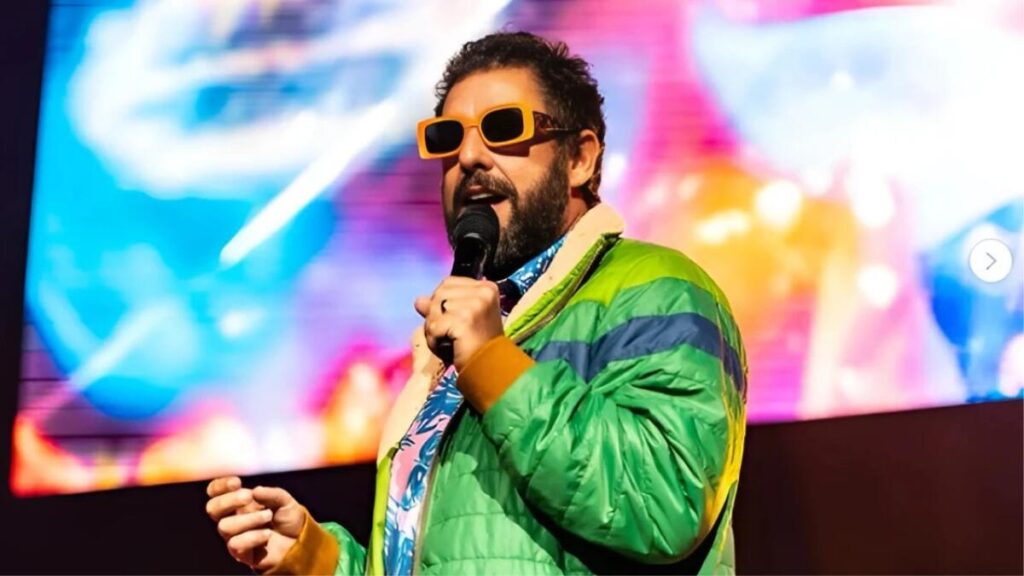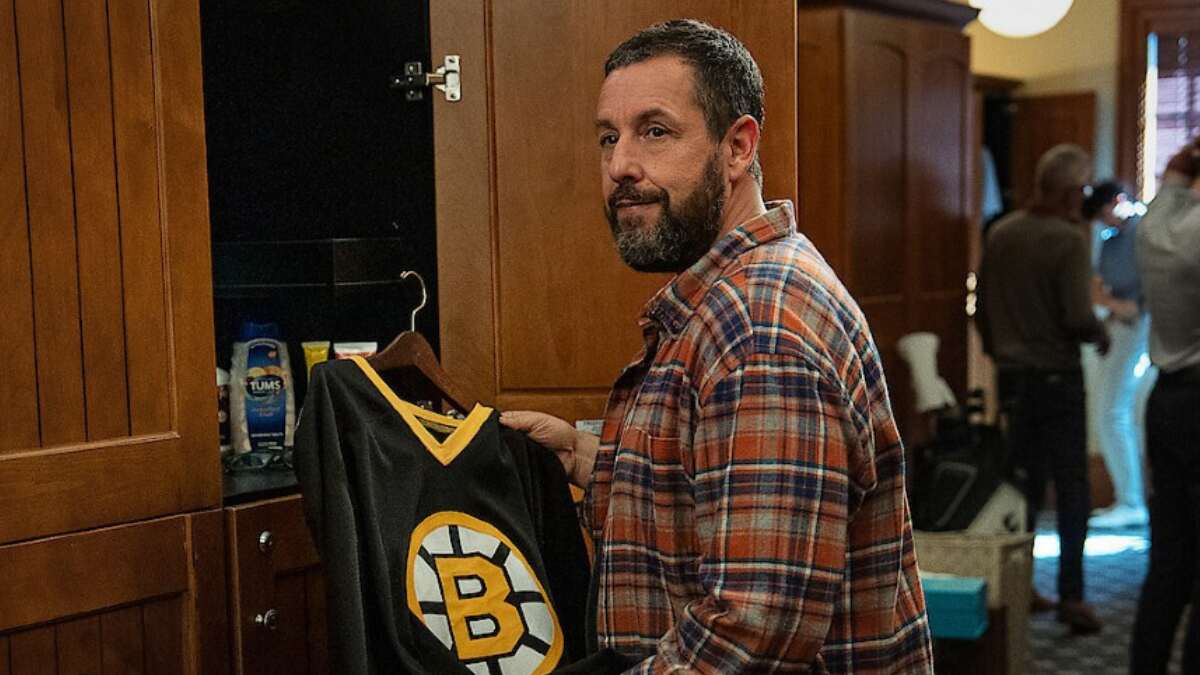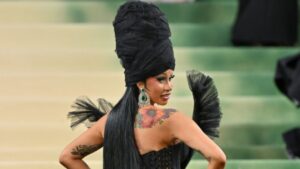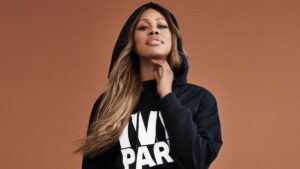For decades, Adam Sandler was the guy who made you laugh with fart jokes, weird voices, and characters named Billy, Happy, or Zohan. Critics scoffed, fans quoted him, and studios kept cashing in—until they didn’t. By the early 2010s, Sandler’s box office magic seemed to vanish, his movies panned as lazy, repetitive, even embarrassing. To many, he looked like a comedic relic coasting on past fame.
And then… he signed a $250 million deal with Netflix.
It wasn’t just a career revival. It was a strategic reinvention. While most of Hollywood was scrambling to keep up with the streaming revolution, Sandler quietly positioned himself ahead of the curve, turning his production company, Happy Madison, into a reliable content engine for the world’s biggest streaming platform. The punchline? His films became some of the most-watched content on Netflix—no awards, no press blitz, just algorithms, audience loyalty, and a deep understanding of what people watch.
This is the story of how Adam Sandler, once written off as a fading clown, became one of streaming’s most powerful players—without changing all that much at all.
Betting on Himself — Before Netflix Knocked
Box Office Burnout Meets Brand Resilience
By the late 2000s, Adam Sandler’s golden run at the box office had started to sputter. Films like Jack and Jill, That’s My Boy, and Bucky Larson were pummeled by critics and underwhelmed at the ticket counter. Entertainment headlines questioned if Sandler’s reign was over, dubbing his humor outdated, his scripts lazy, and his characters recycled.
But off-screen, something else was happening: his core audience wasn’t going anywhere. His movies, no matter how critically panned, found traction on DVD, cable reruns, and eventually streaming. Sandler had long mastered a specific brand of low-stakes, comfort comedy—and it resonated. He wasn’t chasing awards; he was building a familiar universe of lovable doofuses and reliable punchlines that his fans could return to again and again.
While Hollywood measured success by critical acclaim and box office dollars, Sandler’s staying power came from something more elusive: a deeply embedded cultural presence that never really faded, even when the numbers dipped.
Building the Happy Madison Infrastructure
Founded in 1999, Happy Madison Productions began as more than just a credit at the start of a Sandler movie—it was a strategic engine for longevity. By creating his own production company, Sandler carved out a self-sustaining ecosystem where he could greenlight projects, rehire trusted collaborators, and maintain creative control without waiting for studio approval.
The setup was lean, familiar, and efficient. From directors to cast, Sandler kept things in the family—building a production model that prioritized speed, comfort, and low overhead. In a 2014 interview, he noted that he liked “working with people who make [him] laugh,” which translated to a formula that was as emotionally consistent as it was financially viable.
That structure became crucial when streaming disrupted Hollywood. While others scrambled to adapt, Sandler already had a content machine in place. Happy Madison wasn’t just a brand—it was a blueprint, primed for Netflix’s demand for original, repeatable entertainment.
The $250 Million Deal That Changed Streaming Forever
Why Netflix Made the First Move
In 2015, Netflix made an unexpected bet: four original films starring Adam Sandler. At the time, critics raised eyebrows—why invest in a fading comic whose theatrical releases were routinely slammed? But Netflix wasn’t chasing prestige; it was playing the numbers.
Behind the scenes, Netflix’s data told a different story. Sandler’s older films were consistently among the most rewatched titles on the platform. Whether it was The Waterboy or Big Daddy, viewers kept coming back. Ted Sarandos, Netflix’s co-CEO, famously said, “When people watch Adam Sandler movies, they watch them again and again.”
His brand of humor—silly, familiar, and globally understandable—translated well across borders, requiring no cultural decoding. To Netflix, Sandler wasn’t a risk. He was a proven algorithm magnet: comfort content with massive, sticky appeal. The move wasn’t about critical acclaim. It was about engagement. And Sandler, intentionally or not, had already mastered the art of streamable cinema.
Sandler’s Content Strategy: Quantity With Cult Appeal
Sure, The Ridiculous 6 isn’t Shakespeare. But it wasn’t trying to be. Adam Sandler’s Netflix slate, often dismissed as “lazy,” actually reflects a smart understanding of how people consume content in the streaming era. His films aren’t made to win Oscars—they’re built to be watched on a Tuesday night when you want something funny, familiar, and low-commitment.
Sandler leans into quantity, not because he’s churning out filler, but because repetition and accessibility are features, not bugs, in a binge-first culture. These movies are algorithm-friendly: simple plots, recognizable faces, easy laughs. They’re the kind of films that play in the background, get rewatched with friends, and work across language barriers.
It’s a model that prioritizes volume, comfort, and global reach—all things Netflix values. Sandler’s not just keeping up with the digital shift. He’s quietly become one of its savviest players, delivering exactly what the platform (and its users) keeps clicking on.
From ‘Ridiculous 6’ to ‘Hustle’: Shifting Tones, Steady Growth
Experimentation Behind the Gags
While most viewers associate Adam Sandler’s Netflix tenure with goofy comedies like Hubie Halloween or Murder Mystery, a closer look reveals something more ambitious beneath the surface. Quietly, and without much fanfare, Sandler has been experimenting—with tone, with genre, and with expectations.
Take The Meyerowitz Stories (2017), a Noah Baumbach drama where Sandler plays a bitter, aging son reckoning with family wounds. His performance is nuanced, stripped-down, and widely praised—an early glimpse into what he could do when he stepped outside the slapstick lane. Then came Uncut Gems (2019), the anxiety-drenched thriller from the Safdie Brothers. Sandler’s portrayal of Howard Ratner, a chaotic jeweler addicted to risk, was electric and raw, earning him serious awards buzz—even if Oscar voters ultimately snubbed him.
Most recently, Hustle (2022) saw him blend heart, grit, and restraint in a sports drama that felt genuinely personal. These weren’t flukes. They were deliberate forays into territory that allowed Sandler to stretch creatively without abandoning his core audience.
The trick? He never fully divorced himself from the humor or humility that made him famous. Instead, he evolved within it—proving that beneath the gags is a performer (and producer) who understands the value of unpredictability.
Creating a Streaming-First Acting Ensemble
Watch a few Adam Sandler Netflix films back-to-back and you’ll notice a pattern: the same faces keep popping up. Kevin James, Rob Schneider, David Spade, Nick Swardson, and even Jennifer Aniston—they’re not just guest stars, they’re part of a rotating troupe. Think of it as a comedic repertory theatre for the streaming age.
This ensemble approach creates instant familiarity. For viewers, it’s comforting—like settling into a show where you already know the dynamics, the rhythms, the punchlines. And for Netflix’s algorithm? It’s a dream. The more overlap across titles, the easier it is to recommend Sandler-adjacent content, boosting engagement with minimal friction.
But beyond strategy, there’s a deeper layer: Sandler genuinely seems to enjoy working with his friends. These aren’t just cast lists—they’re friendships that double as professional shorthand. That easy chemistry translates on screen, giving the films a hangout vibe that’s hard to fake.
In a media world flooded with new faces and high-concept noise, Sandler’s ensemble model offers something low-key but powerful: emotional continuity. You may not remember every plot, but you know exactly how it’ll feel—and that’s often what brings people back.
Inside the Business Model — Sandler as Producer, Brand, and Algorithm Magnet
Profitable Mediocrity or Strategic Brilliance?
Call them mediocre, lazy, or formulaic—but Adam Sandler’s Netflix films consistently top the platform’s most-watched lists. Murder Mystery pulled in over 80 million household views in its first month. Hubie Halloween, a goofy seasonal comedy, ranked among the top 10 global titles during its debut week. The numbers don’t lie.
In the streaming economy, viewer retention and rewatchability matter more than glowing reviews. Prestige films may win awards, but they often have a short attention span—watched once, then forgotten. Sandler’s content, by contrast, is engineered for longevity. His brand of humor is endlessly accessible, perfect for passive viewing and background replays.

Netflix isn’t paying Sandler for cinematic breakthroughs—they’re paying for predictable, repeatable engagement. That’s not laziness. That’s strategy. He delivers exactly what the platform wants: reliable, rewatchable content with built-in audience trust. In a world where data trumps critics, Sandler’s so-called mediocrity might just be algorithmic brilliance.
Merchandising, Licensing, and IP Synergy
Adam Sandler has never been known as an IP factory—but maybe he should be. With the success of Hotel Transylvania (where he voiced Dracula across three films), it’s clear his characters can cross into franchisable territory, especially in animation. So why not explore similar potential within his Netflix universe?
Take Hubie Halloween, a goofy, PG-friendly setup already rich with quirky characters, slapstick gags, and seasonal appeal. It could easily lend itself to an animated series or a line of Halloween-themed merchandise aimed at families. Even his broader comedy ensemble—think the cast of Grown Ups or The Week Of—could inspire spin-offs or stylized adaptations, especially for younger viewers or international markets.
Creators like Kevin Hart (with Laugh Out Loud) and Ryan Reynolds (via Maximum Effort) are actively building multiplatform brands. Sandler, with his deep catalog and distinctive voice, has the foundation to do the same—if not louder, then sneakier. The next Sandler expansion may not hit theaters—it might just land on a lunchbox or a mobile screen.
Sandler vs. the Streaming Stars: How He Compares to Peers Like Kevin Hart and Ryan Reynolds
Adam Sandler isn’t the only A-lister to find a second (or third) act in streaming—but the way he’s done it stands apart. Where Kevin Hart and Ryan Reynolds have leaned into overt brand-building and cross-platform entrepreneurship, Sandler has taken a quieter, more insular route—one that relies less on self-promotion and more on consistency, familiarity, and sheer volume.
Kevin Hart’s Laugh Out Loud network positions him as a mogul with a multi-pronged strategy: stand-up specials, scripted series, branded partnerships, and a relentless social media presence. Ryan Reynolds, through Maximum Effort, mixes content production with savvy marketing, turning even movie trailers into viral events. Both are personalities as much as they are performers.
Sandler, on the other hand, keeps it low-key. His empire is built on comfort-content repetition, long-term partnerships, and the value of being algorithm-friendly rather than headline-grabbing. He may not be building a tequila brand or dropping Super Bowl ads—but he’s dominating watch-time metrics all the same.
Streaming Star Comparison Table
| Celebrity | Platform(s) | Strategy Focus | Signature Content | Brand Tone |
| Adam Sandler | Netflix | High-volume, low-friction | Comedies, light drama | Familiar, nostalgic |
| Kevin Hart | Peacock, LOL Net | Franchise-building, verticals | Stand-up, sitcoms, docs | Energetic, hustle-heavy |
| Ryan Reynolds | Netflix, AppleTV+ | Viral branding + storytelling | Action-comedy, meta humor | Slick, irreverent |
Each of them is redefining celebrity content creation—but Sandler’s staying power may come from doing it his way, under the radar.
Why I Keep Watching Sandler on Netflix
I’m not going to pretend The Do-Over changed my life. It didn’t. But on a Friday night after a long week, with takeout on the coffee table and my brain officially out of office, it was exactly what I needed.
There’s something about Adam Sandler’s Netflix movies that feels like comfort food—predictable, a little cheesy, but deeply satisfying. I know the jokes won’t be groundbreaking, the plots might veer into absurd, and someone’s probably going to fall down a hill. But that’s kind of the point. I don’t have to work for it. I just get to laugh.
Hustle caught me off guard, though. I watched it expecting another throwaway comedy, but what I got was a low-key, heartfelt sports drama that stuck with me for days. It reminded me that Sandler still surprises us when he wants to.
I think that’s why I keep watching. His films—especially the Netflix ones—live in this strange space between nostalgia and now. They’re easy. They’re familiar. And occasionally, they remind you that even a goofball in basketball shorts can deliver something meaningful. That’s not just entertainment. That’s comfort—and sometimes, that’s exactly what streaming is for.
What the Industry Learned from Sandler’s Streaming Playbook
Data Over Drama — How Numbers Trump Reviews
In the streaming era, success isn’t judged by Rotten Tomatoes scores—it’s measured in hours watched. Adam Sandler’s Netflix films may get panned by critics, but they consistently top viewership charts. Murder Mystery drew over 80 million households in its first month, and Hustle ranked in Netflix’s global Top 10 for weeks.
To Netflix, that’s gold. Engagement drives subscriber retention, and Sandler delivers it reliably. While a critic might call Hubie Halloween a flop, the data tells another story: people watch, rewatch, and come back for more.
In a traditional box office model, perception shaped profit. But on streaming platforms, the opposite is true—viewership drives value, and the algorithm doesn’t care about reviews. Sandler wins because he understands the real audience lives behind the play button.
The Rise of Platform-First Celebrities
While Hollywood chased theatrical glory, Adam Sandler quietly rewrote the playbook—becoming one of the first major stars to go all-in on a single streaming platform. His Netflix-first model was seen as unconventional in 2015. Now, it’s the blueprint.
Today, stars like Reese Witherspoon (with Hello Sunshine’s streaming deals) and Donald Glover (with his exclusive pact with Amazon) are building platform-centric empires, blending production, acting, and brand identity. But Sandler was there first—signing a $250 million deal without fanfare, just output.
His approach was less about buzz and more about volume and loyalty. In doing so, he helped normalize the idea that streaming wasn’t a fallback—it was the main stage. The result? Studios are no longer the only gatekeepers. Stars are becoming ecosystems.
Not Just a Punchline — A Streaming Pioneer in Disguise
For years, Adam Sandler was treated like the class clown of Hollywood—good for a laugh, rarely taken seriously. But if you look past the goofy voices and pratfalls, a different picture emerges: that of a performer who saw the future before most of his peers did.
While others clung to theatrical prestige, Sandler quietly leaned into streaming, building a steady, repeatable model that rewarded comfort over novelty and consistency over acclaim. He didn’t chase headlines or try to rebrand himself as a reinvented artist. Instead, he did what he’s always done—just smarter, faster, and on his terms.
Now, in a media landscape defined by fractured attention and algorithmic recommendations, Sandler stands out not as an outlier but as a pioneer. His formula—familiar faces, loyal audiences, and a production machine that never really stops—turned out to be exactly what the streaming era wanted.
So maybe the joke’s on us. Or maybe Sandler’s been in on it the whole time. Either way, the next time you scroll past one of his Netflix movies, don’t just roll your eyes. You might be looking at one of the quiet architects of modern entertainment.
Nishant Wagh is the founder of The Graval and a seasoned SEO and content strategist with over 15 years of experience. He writes with a focus on digital influence, authority, and long-term search visibility.





6 thoughts on “How Adam Sandler Quietly Built a Netflix-First Film Empire Through Happy Madison and Audience Loyalty”